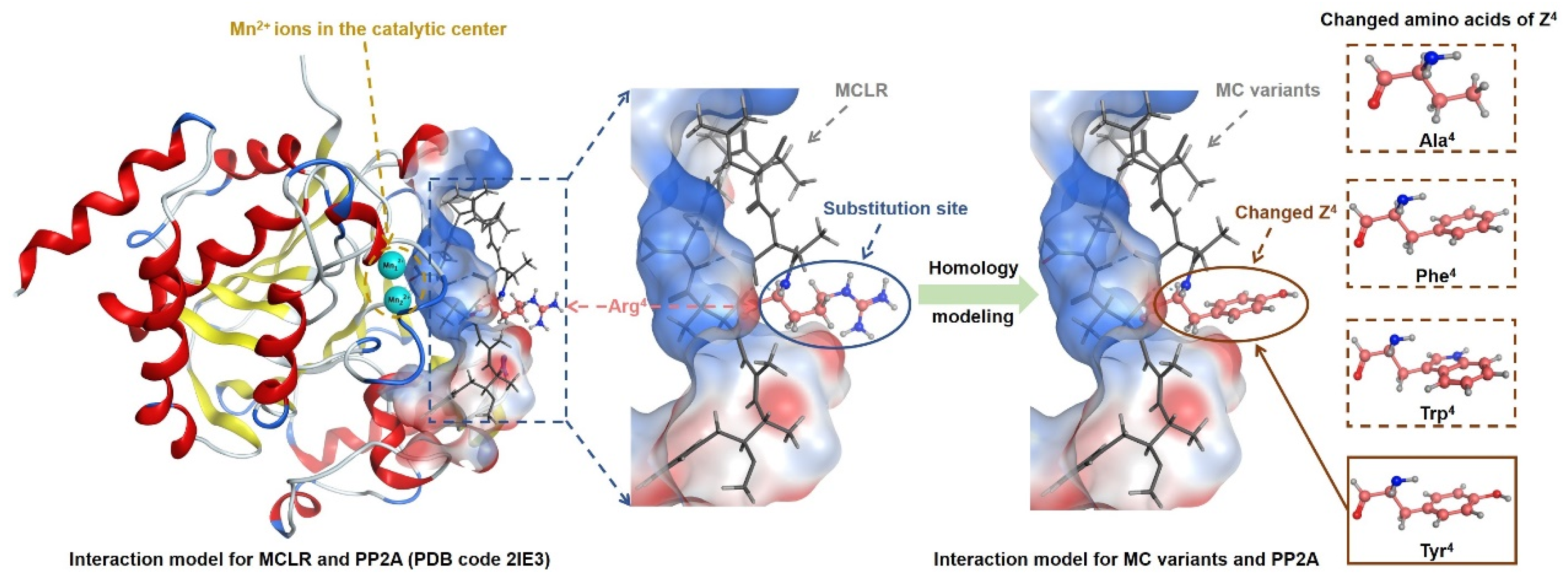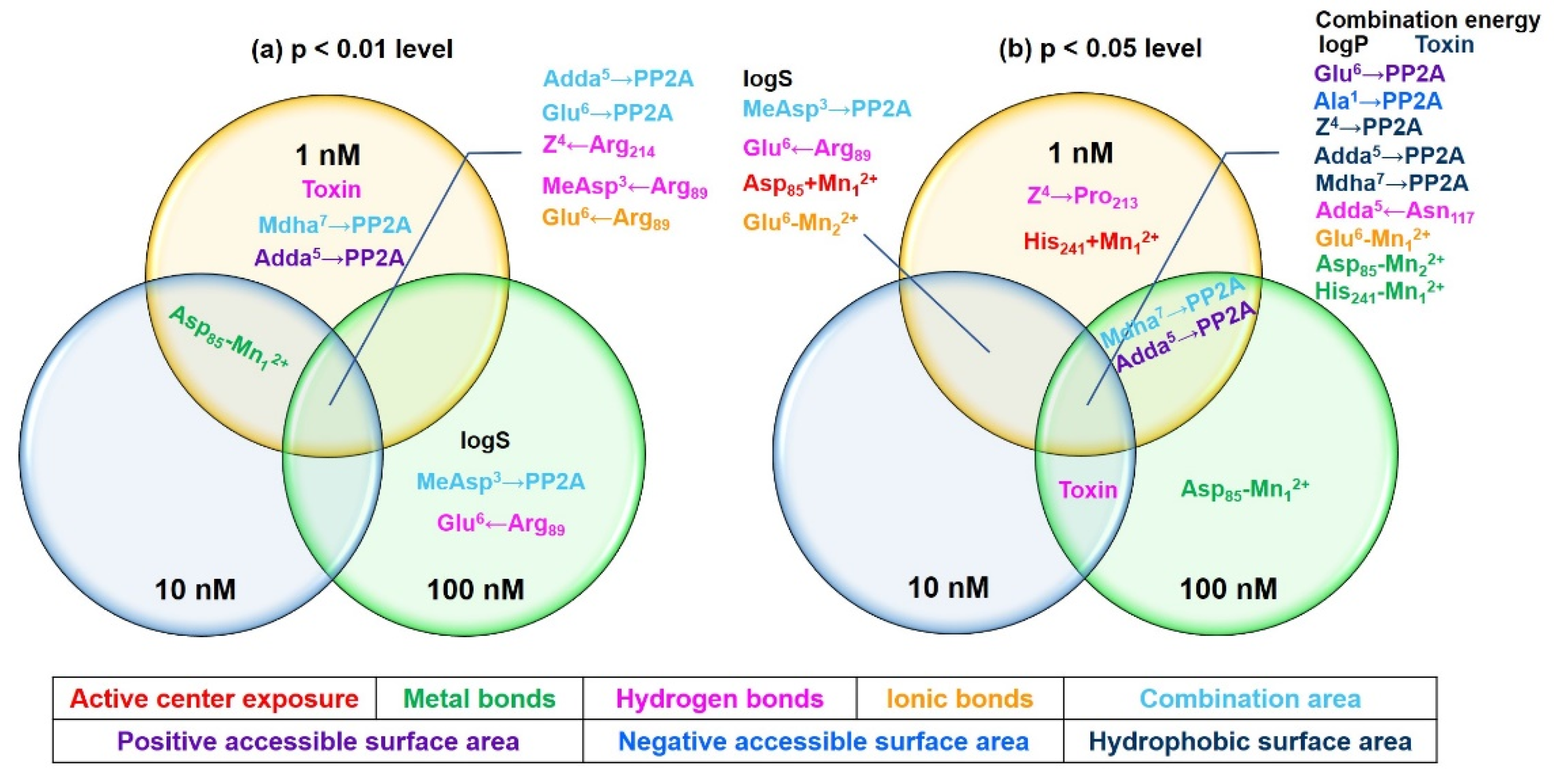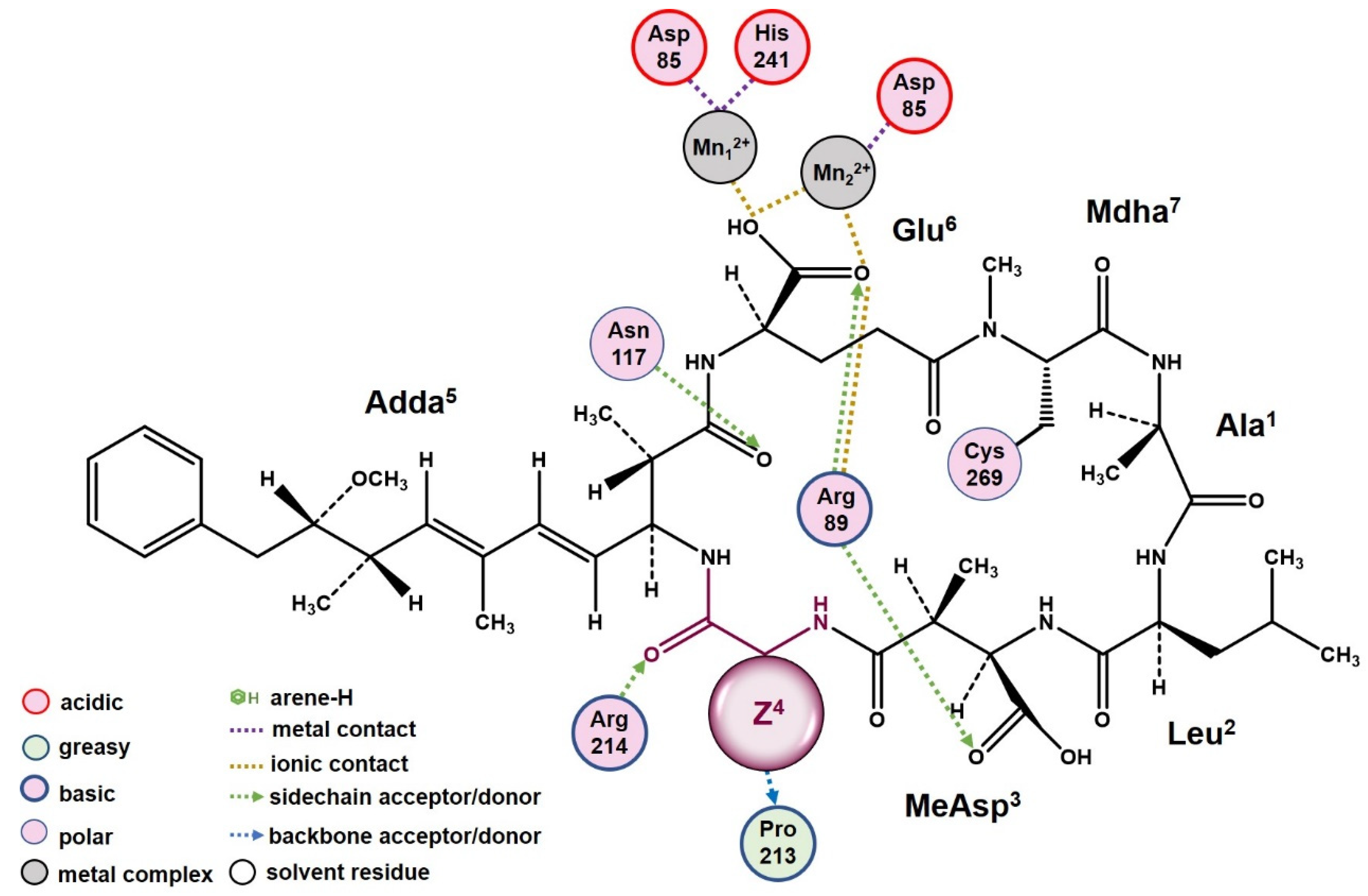Insight into the Molecular Mechanism for the Discrepant Inhibition of Microcystins (MCLR, LA, LF, LW, LY) on Protein Phosphatase 2A
Abstract
:1. Introduction
2. Results and Discussion
2.1. Evaluation of the Inhibition Effect of Typical MCs Targeted to PP2A
2.2. Filtration of the Major Interaction Parameters between MCs and PP2A Based on Homology Modeling
2.3. Pearson Correlation Analysis for Inhibition Data and the Major Interaction Parameters
2.4. Molecular Mechanism Analysis of the Discrepant Inhibition of MCs on PP2A
3. Conclusions
4. Materials and Methods
4.1. Materials
4.2. PP2A Inhibition Assay
4.3. Molecular Docking for the Interactions between MCs and PP2A
4.4. Statistical Analysis
Supplementary Materials
Author Contributions
Funding
Institutional Review Board Statement
Informed Consent Statement
Data Availability Statement
Conflicts of Interest
References
- Pestana, C.J.; Moura, D.S.; Capelo-Neto, J.; Edwards, C.; Dreisbach, D.; Spengler, B.; Lawton, L.A. Potentially Poisonous Plastic Particles: Microplastics as a Vector for Cyanobacterial Toxins Microcystin-LR and Microcystin-LF. Environ. Sci. Technol. 2021, 55, 15940–15949. [Google Scholar] [CrossRef] [PubMed]
- Schreidah, C.M.; Ratnayake, K.; Senarath, K.; Karunarathne, A. Microcystins: Biogenesis, Toxicity, Analysis, and Control. Chem. Res. Toxicol. 2020, 33, 2225–2246. [Google Scholar] [CrossRef] [PubMed]
- Puerto, M.; Pichardo, S.; Jos, A.; Camean, A.M. Comparison of the toxicity induced by microcystin-RR and microcystin-YR in differentiated and undifferentiated Caco-2 cells. Toxicon 2009, 54, 161–169. [Google Scholar] [CrossRef] [PubMed]
- Sedan, D.; Andrinolo, D.; Telese, L.; Giannuzzi, L.; de Alaniz, M.J.; Marra, C.A. Alteration and recovery of the antioxidant system induced by sub-chronic exposure to microcystin-LR in mice: Its relation to liver lipid composition. Toxicon 2010, 55, 333–342. [Google Scholar] [CrossRef] [PubMed]
- Takai, A.; Eto, M.; Hirano, K.; Takeya, K.; Wakimoto, T.; Watanabe, M. Protein phosphatases 1 and 2A and their naturally occurring inhibitors: Current topics in smooth muscle physiology and chemical biology. J. Physiol. Sci. 2018, 68, 1–17. [Google Scholar] [CrossRef] [PubMed] [Green Version]
- Nasa, I.; Rusin, S.F.; Kettenbach, A.N.; Moorhead, G.B. Aurora B opposes PP1 function in mitosis by phosphorylating the conserved PP1-binding RVxF motif in PP1 regulatory proteins. Sci. Signal. 2018, 11. [Google Scholar] [CrossRef] [Green Version]
- Campos, A.; Vasconcelos, V. Molecular mechanisms of microcystin toxicity in animal cells. Int. J. Mol. Sci. 2010, 11, 268–287. [Google Scholar] [CrossRef] [Green Version]
- Zaidi, H.; Amrani, A.; Sedrati, F.; Maaref, H.; Leghrib, F.; Benamara, M.; Amara, H.; Wang, Z.; Nasri, H. Histological and chemical damage induced by microcystin-LR and microcystin-RR on land snail Helix aspersa tissues after acute exposure. Comp. Biochem. Physiol. C Toxicol. Pharmacol. 2021, 245, 109031. [Google Scholar] [CrossRef]
- Jayaraj, R.; Deb, U.; Bhaskar, A.S.; Prasad, G.B.; Rao, P.V. Hepatoprotective efficacy of certain flavonoids against microcystin induced toxicity in mice. Environ. Toxicol. 2007, 22, 472–479. [Google Scholar] [CrossRef]
- Chen, G.; Zheng, Z.; Bai, M.; Li, Q. Chronic effects of microcystin-LR at environmental relevant concentrations on photosynthesis of Typha angustifolia Linn. Ecotoxicology 2020, 29, 514–523. [Google Scholar] [CrossRef]
- Torres, M.A.; Micheletto, J.; de Liz, M.V.; Pagioro, T.A.; Rocha Martins, L.R.; Martins de Freitas, A. Microcystis aeruginosa inactivation and microcystin-LR degradation by the photo-Fenton process at the initial near-neutral pH. Photochem. Photobiol. Sci. 2020, 19, 1470–1477. [Google Scholar] [CrossRef] [PubMed]
- Gadgil, A. Drinking water in developing countries. Annu. Rev. Energy Environ. 1998, 23, 253–286. [Google Scholar] [CrossRef] [Green Version]
- de Figueiredo, D.R.; Azeiteiro, U.M.; Esteves, S.M.; Goncalves, F.J.; Pereira, M.J. Microcystin-producing blooms--a serious global public health issue. Ecotoxicol. Environ. Saf. 2004, 59, 151–163. [Google Scholar] [CrossRef] [PubMed]
- Maynes, J.T.; Perreault, K.R.; Cherney, M.M.; Luu, H.A.; James, M.N.; Holmes, C.F. Crystal structure and mutagenesis of a protein phosphatase-1:calcineurin hybrid elucidate the role of the beta12-beta13 loop in inhibitor binding. J. Biol. Chem. 2004, 279, 43198–43206. [Google Scholar] [CrossRef] [Green Version]
- Liu, J.; Sun, Y. The role of PP2A-associated proteins and signal pathways in microcystin-LR toxicity. Toxicol. Lett. 2015, 236, 1–7. [Google Scholar] [CrossRef]
- Parker, C.H.; Stutts, W.L.; DeGrasse, S.L. Development and Validation of a Liquid Chromatography-Tandem Mass Spectrometry Method for the Quantitation of Microcystins in Blue-Green Algal Dietary Supplements. J. Agric. Food Chem. 2015, 63, 10303–10312. [Google Scholar] [CrossRef]
- Pichardo, S.; Jos, A.; Zurita, J.L.; Salguero, M.; Camean, A.M.; Repetto, G. Acute and subacute toxic effects produced by microcystin-YR on the fish cell lines RTG-2 and PLHC-1. Toxicol. In Vitro 2007, 21, 1460–1467. [Google Scholar] [CrossRef]
- Wang, Q.; Wang, X.; Zhang, S.; Zong, W. Molecular mechanism for the discrepant inhibition of microcystins on protein phosphatase 1. Environ. Sci. Pollut. Res. 2019, 26, 21774–21783. [Google Scholar] [CrossRef]
- Zhang, Z.; Yang, M.; Yi, J.; Zhu, Q.; Huang, C.; Chen, Y.; Li, J.; Yang, B.; Zhao, X. Comprehensive Insights into the Interactions of Two Emerging Bromophenolic DBPs with Human Serum Albumin by Multispectroscopy and Molecular Docking. ACS Omega 2019, 4, 563–572. [Google Scholar] [CrossRef]
- Khan, S.N.; Islam, B.; Yennamalli, R.; Sultan, A.; Subbarao, N.; Khan, A.U. Interaction of mitoxantrone with human serum albumin: Spectroscopic and molecular modeling studies. Eur. J. Pharm. Sci. 2008, 35, 371–382. [Google Scholar] [CrossRef]
- Das, S.; Bora, N.; Rohman, M.A.; Sharma, R.; Jha, A.N.; Singha Roy, A. Molecular recognition of bio-active flavonoids quercetin and rutin by bovine hemoglobin: An overview of the binding mechanism, thermodynamics and structural aspects through multi-spectroscopic and molecular dynamics simulation studies. Phys. Chem. Chem. Phys. 2018, 20, 21668–21684. [Google Scholar] [CrossRef] [PubMed]
- Zong, W.; Sun, F.; Pei, H.; Hu, W.; Pei, R. Microcystin-associated disinfection by-products: The real and non-negligible risk to drinking water subject to chlorination. Chem. Eng. J. 2015, 279, 498–506. [Google Scholar] [CrossRef]
- Zong, W.; Wang, Q.; Zhang, S.; Teng, Y.; Du, Y. Regulation on the toxicity of microcystin-LR target to protein phosphatase 1 by biotransformation pathway: Effectiveness and mechanism. Environ. Sci. Pollut. Res. Int. 2018, 25, 26020–26029. [Google Scholar] [CrossRef] [PubMed]
- Chen, H.; Fu, W.; Wang, Z.; Wang, X.; Lei, T.; Zhu, F.; Li, D.; Chang, S.; Xu, L.; Hou, T. Reliability of Docking-Based Virtual Screening for GPCR Ligands with Homology Modeled Structures: A Case Study of the Angiotensin II Type I Receptor. ACS Chem. Neurosci. 2019, 10, 677–689. [Google Scholar] [CrossRef] [PubMed]
- Wiltgen, M.; Tilz, G.P. Homology modelling: A review about the method on hand of the diabetic antigen GAD 65 structure prediction. Wien. Med. Wochenschr. 2009, 159, 112–125. [Google Scholar] [CrossRef]
- Loo, J.S.E.; Emtage, A.L.; Ng, K.W.; Yong, A.S.J.; Doughty, S.W. Assessing GPCR homology models constructed from templates of various transmembrane sequence identities: Binding mode prediction and docking enrichment. J. Mol. Graph. Model. 2018, 80, 38–47. [Google Scholar] [CrossRef]






| Correlation Analysis Data a | Combination Energy (KJ/Mol) | Combination Area (Å2) | ||||||||
|---|---|---|---|---|---|---|---|---|---|---|
| Total | Ala1→PP2A | Leu2→PP2A | MeAsp3→PP2A | Z4→PP2A | Adda5→PP2A | Glu6→PP2A | Mdha7→PP2A | |||
| 1 nM b | R (p) | −0.892 * (0.042) | 0.346 (0.569) | −0.392 (0.514) | −0.341 (0.574) | 0.902 * (0.037) | 0.282 (0.646) | 0.978 ** (0.004) | 0.979 ** (0.004) | 0.978 ** (0.004) |
| 10 nM b | R (p) | −0.890 * (0.043) | 0.464 (0. 431) | −0.438 (0. 461) | −0.254 (0.680) | 0.951 * (0.013) | 0.413 (0.490) | 0.994 ** (0.001) | 0.996 ** (0.000) | 0.956 * (0.011) |
| 100 nM b | R (p) | −0.888 * (0.044) | 0.523 (0.365) | −0.538 (0.350) | −0.172 (0.782) | 0.982 ** (0.003) | 0.492 (0.400) | 0.980 ** (0.003) | 0.979 ** (0.004) | 0.910 * (0.032) |
| Correlation Analysis Data a | logP (o/w) | Positive accessible surface area (Å2) | ||||||||
| Total | Ala1→PP2A | Leu2→PP2A | MeAsp3→PP2A | Z4→PP2A | Adda5→PP2A | Glu6→PP2A | Mdha7→PP2A | |||
| 1 nM | R (p) | −0.929 * (0.023) | 0.456 (0.440) | −0.765 (0.132) | −0.652 (0.233) | 0.125 (0.841) | 0.177 (0.775) | 0.888 ** (0.044) | 0.910 * (0.032) | −0.386 (0.521) |
| 10 nM | R (p) | −0.936 * (0.019) | 0.581 (0.305) | −0.712 (0.177) | −0.560 (0.326) | 0.245 (0.691) | 0.321 (0.598) | 0.905 * (0.034) | 0.922 * (0.026) | −0.410 (0.494) |
| 100 nM | R (p) | −0.888 * (0.044) | 0.660 (0.226) | −0.593 (0.292) | −0.419 (0.483) | 0.345 (0.570) | 0.424 (0.477) | 0.900 * (0.037) | 0.886 * (0.046) | −0.345 (0.569) |
| Correlation Analysis Data a | logS | Negative accessible surface area (Å2) | ||||||||
| Total | Ala1→PP2A | Leu2→PP2A | MeAsp3→PP2A | Z4→PP2A | Adda5→PP2A | Glu6→PP2A | Mdha7→PP2A | |||
| 1 nM | R (p) | 0.884 * (0.046) | 0.388 (0.519) | 0.882 * (0.048) | −0.548 (0.339) | 0.394 (0.512) | 0.466 (0.429) | 0.378 (0.530) | 0.474 (0.419) | −0.140 (0.822) |
| 10 nM | R (p) | 0.925 * (0.025) | 0.512 (0. 378) | 0.892 * (0.042) | −0.607 (0.278) | 0.324 (0.595) | 0.560 (0.326) | 0.390 (0.516) | 0.378 (0.531) | −0.225 (0.716) |
| 100 nM | R (p) | 0.966 ** (0.008) | 0.585 (0.300) | 0.915 * (0.029) | −0.707 (0.182) | 0.179 (0.773) | 0.583 (0.302) | 0.429 (0.471) | 0.303 (0.620) | −0.365 (0.546) |
| Correlation Analysis Data a | Hydrophobic surface area (Å2) | |||||||||
| Total | Ala1→PP2A | Leu2→PP2A | MeAsp3→PP2A | Z4→PP2A | Adda5→PP2A | Glu6→PP2A | Mdha7→PP2A | |||
| 1 nM | R (p) | −0.929 * (0.022) | −0.087 (0.889) | 0.590 (0.295) | −0.763 (0.134) | −0.900 * (0.038) | 0.924 * (0.025) | 0.564 (0.322) | 0.934 * (0.020) | |
| 10 nM | R (p) | −0.920 * (0.027) | −0.033 (0.958) | 0.607 (0.277) | −0.734 (0.158) | −0.938 * (0.018) | 0.953 * (0.012) | 0.645 (0.240) | 0.923 * (0.026) | |
| 100 nM | R (p) | −0.889 * (0.044) | 0.063 (0.920) | 0.546 (0.341) | −0.730 (0.161) | −0.932 * (0.021) | 0.953 * (0.012) | 0.757 (0.138) | 0.891 * (0.042) | |
| Correlation Analysis Data a | Hydrogen bonds (KJ/Mol) | |||||||||
| Total | Z4→Pro213 | Ala1←Arg268 | Leu2←Arg89 | MeAsp3←Arg89 | Z4←Arg214 | Adda5←His118 | Glu6←Arg89 | Mdha7←Arg268 | ||
| 1 nM | R (p) | −0.980 ** (0.003) | −0.893 * (0.041) | −0.244 (0.693) | −0.780 (0.119) | −0.977 ** (0.004) | −0.995 ** (0.000) | 0.216 (0.727) | −0.880 * (0.049) | −0.020 (0.975) |
| 10 nM | R (p) | −0.953 * (0.012) | −0.841 (0.074) | −0.372 (0.537) | −0.798 (0.106) | −0.993 ** (0.001) | −0.995 ** (0.000) | 0.284 (0.643) | −0.938 * (0.018) | 0.128 (0.837) |
| 100 nM | R (p) | −0.901 * (0.037) | −0.764 (0.133) | −0.521 (0.368) | −0.777 (0.122) | −0.991 ** (0.001) | −0.971 ** (0.006) | 0.319 (0.600) | −0.984 ** (0.002) | 0.296 (0.628) |
| Correlation Analysis Data a | Hydrogen bond | Metal bonds (KJ/Mol) | ||||||||
| Adda5←Asn117 | Total | Glu6-Mn12+ | Glu6-Mn22+ | Asp57-Mn12+ | Asp57-Mn22+ | Asp85-Mn12+ | Asp85-Mn22+ | His241-Mn12+ | ||
| 1 nM | R (p) | −0.904 * (0.035) | −0.519 (0.371) | 0.517 (0.372) | 0.731 (0.161) | 0.742 (0.151) | −0.850 (0.068) | −0.985 ** (0.002) | −0.935 * (0.020) | 0.926 * (0.024) |
| 10 nM | R (p) | −0.946 * (0.015) | −0.571 (0.314) | 0.400 (0.505) | 0.621 (0.264) | 0.792 (0.110) | −0.796 (0.107) | −0.964 ** (0.008) | −0.937 * (0.019) | 0.956 * (0.011) |
| 100 nM | R (p) | −0.959 * (0.001) | −0.669 (0.217) | 0.287 (0.640) | −0.480 (0.414) | 0.773 (0.126) | −0.688 (0.199) | −0.904 * (0.035) | −0.894 * (0.041) | 0.936 * (0.019) |
| Correlation Analysis Data a | Ionic bonds (KJ/Mol) | |||||||||
| Total | Leu2←Arg89 | MeAsp3←Arg89 | Glu6←Arg89 | Glu6-Mn12+ | Glu6-Mn22+ (c) | Asp57-Mn12+ | Asp57-Mn22+ | Asp85-Mn12+ | ||
| 1 nM | R (p) | 0.794 (0.108) | 0.301 (0.623) | −0.171 (0.784) | 0.989 ** (0.001) | 0.914 * (0.030) | 0.955 * (0.012) | 0.665 (0.221) | 0.622 (0.262) | 0.445 (0.452) |
| 10 nM | R (p) | 0.735 (0.157) | 0.293 (0.633) | −0.017 (0.978) | 0.994 ** (0.001) | 0.928 * (0.023) | 0.904 * (0.035) | 0.773 (0.125) | 0.549 (0.338) | 0.325 (0.593) |
| 100 nM | R (p) | 0.660 (0.225) | 0.246 (0.690) | 0.146 (0.815) | 0.964 ** (0.008) | 0.886 * (0.046) | 0.817 (0.091) | 0.858 (0.063) | 0.470 (0.424) | 0.177 (0.776) |
| Correlation Analysis Data a | Ionic bond | Active center exposure (Å2) | ||||||||
| Asp85-Mn22+ | Asn117 + Mn12+ | Asp85 + Mn12+ | Asp57 + Mn12+ | His241 + Mn12+ | Asp85 + Mn22+ | Asp57 + Mn22+ | ||||
| 1 nM | R (p) | −0.171 (0.784) | 0.874 (0.053) | −0.955 * (0.011) | −0.787 (0.114) | −0.885 * (0.046) | −0.735 (0.157) | −0.628 (0.257) | ||
| 10 nM | R (p) | −0.017 (0.978) | 0.819 (0.090) | −0.957 * (0.010) | −0.786 (0.115) | −0.878 (0.050) | −0.759 (0.137) | −0.658 (0.228) | ||
| 100 nM | R (p) | 0.146 (0.815) | −0.739 (0.154) | −0.809 (0.097) | −0.724 (0.166) | −0.629 (0.255) | −0.724 (0.166) | −0.629 (0.255) | ||
Publisher’s Note: MDPI stays neutral with regard to jurisdictional claims in published maps and institutional affiliations. |
© 2022 by the authors. Licensee MDPI, Basel, Switzerland. This article is an open access article distributed under the terms and conditions of the Creative Commons Attribution (CC BY) license (https://creativecommons.org/licenses/by/4.0/).
Share and Cite
Xu, Y.; Cui, J.; Yu, H.; Zong, W. Insight into the Molecular Mechanism for the Discrepant Inhibition of Microcystins (MCLR, LA, LF, LW, LY) on Protein Phosphatase 2A. Toxins 2022, 14, 390. https://doi.org/10.3390/toxins14060390
Xu Y, Cui J, Yu H, Zong W. Insight into the Molecular Mechanism for the Discrepant Inhibition of Microcystins (MCLR, LA, LF, LW, LY) on Protein Phosphatase 2A. Toxins. 2022; 14(6):390. https://doi.org/10.3390/toxins14060390
Chicago/Turabian StyleXu, Yixue, Jiyuan Cui, Huiqun Yu, and Wansong Zong. 2022. "Insight into the Molecular Mechanism for the Discrepant Inhibition of Microcystins (MCLR, LA, LF, LW, LY) on Protein Phosphatase 2A" Toxins 14, no. 6: 390. https://doi.org/10.3390/toxins14060390
APA StyleXu, Y., Cui, J., Yu, H., & Zong, W. (2022). Insight into the Molecular Mechanism for the Discrepant Inhibition of Microcystins (MCLR, LA, LF, LW, LY) on Protein Phosphatase 2A. Toxins, 14(6), 390. https://doi.org/10.3390/toxins14060390





